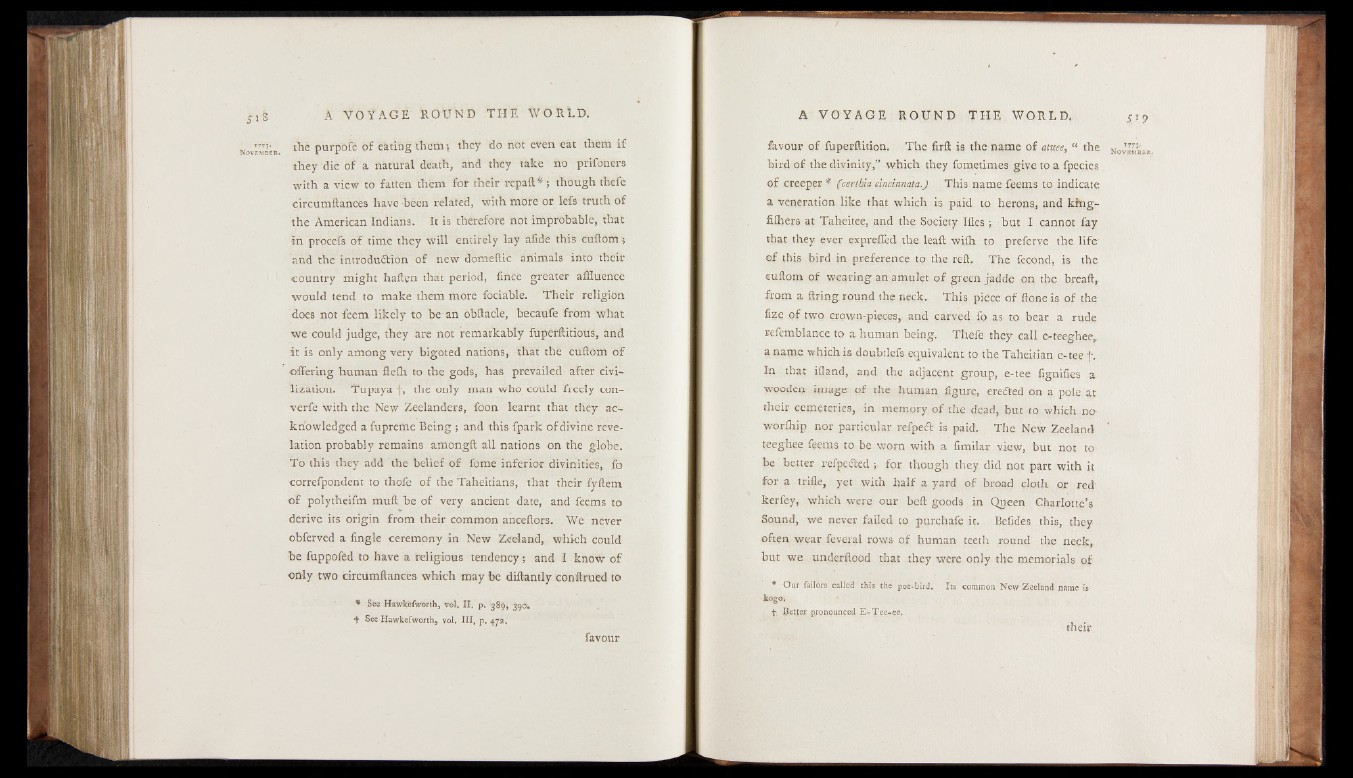
À V 518- O Y A G E ROUND THE WORLD.
novemmr the purpofe of eating them; they do not even eat them if
they die of a natural death, and they take no prifoners
■ with a view to fatten them for their repaft * ; though thefe
circumftances have -been related, with more or lefs truth of
the American Indians. It is therefore not improbable, that
•in procefs of time they will entirely lay afide this cuftom $
and the introduction of new domeftic animals into their
country might haften that period, fince greater affluence
would tend to make them more fociable. Their religion
does not feem likely to be an obftacle, becaufe from what
we could judge, they are not remarkably füperftitious, and
it is only among very bigoted nations, that the cuftom of
offering human fiefh to the gods, has prevailed after civilization.
Tupaya f , the only man who could freely con-
verfe with the New Zeelanders, foon learnt that they acknowledged
afupreme Being ; and this fpark of divine revelation
probably remains amongft all nations on the globe.
To this they add the belief of fome inferior divinities, fo
correfpondent to thofe of the Taheitians, that their fyftem
o f polytheifm muft be of very ancient date, and feems to
derive its origin from their common anceftors. We never
obferved a Angle ceremony in New Zeeland, which could
be fuppofèd to have a religious tendency ; and I know of
only two circumftances which may be diftantly conftrued to
* See Hawkefw'órth, vol. II. p. 289, 39Ó*
+ See Hawkefworth, vol. I l l , p. 472.
favour
A V O Y A G E ROUND THE WORLD.
favour of fuperftition. The firft is the name of atuee, “ the N(1™;tli
bird of the divinity,” which they fometimes give to a fpecies
of creeper * (certhia cincinnata.) This name feems to indicate
a veneration like that which is paid to herons, and khig-
fflhers at Taheitee, and the Society Iftes ; but I cannot fay
that they ever exprefled the leaft wifh to preferve the life'
of this bird in preference to the reft. The fecond, is the
cuftom of wearing an amulet of green jadde on the breaft,
from a firing round the neck. This piece of ftone is of the
fize of two crown-pieces, and carved fo as to bear a rude
refcmblance to a human being. Thefe they call e-teeghee,
a name which is doubtlefs equivalent to the Taheitian e-tee f.
In that ifland, and the adjacent group, e-tee fignifies a
wooden image of the human figure, eredted on a pole at
their cemeteries, in memory of the dead, but to which no
worfhip nor particular refpeft is paid. The New Zeeland '
teeghee feems to be worn with a fimilar view, but not to-
be better refpefted ; for though they did not part with it
for a trifle, yet with half a yard of broad cloth or red
kerfey, which were our belt goods in Queen Charlotte’s
Sound, we never failed to purchafe it. Befides this, they
often wear feveral rows of human teeth round the neck,
but we underftood that they were only the memorials of
* Our tailors called this the poe-bird. Its common New Zeeland name is
kogoi
t Better pronounced E -T e e -e e ,.
their